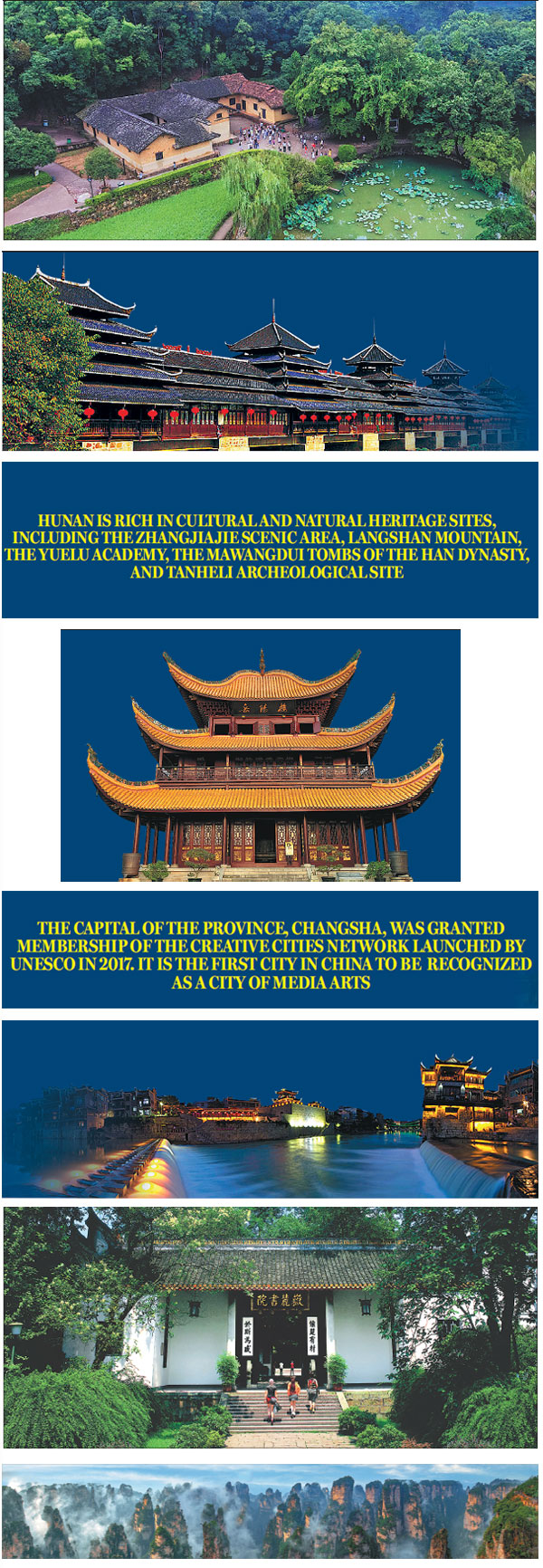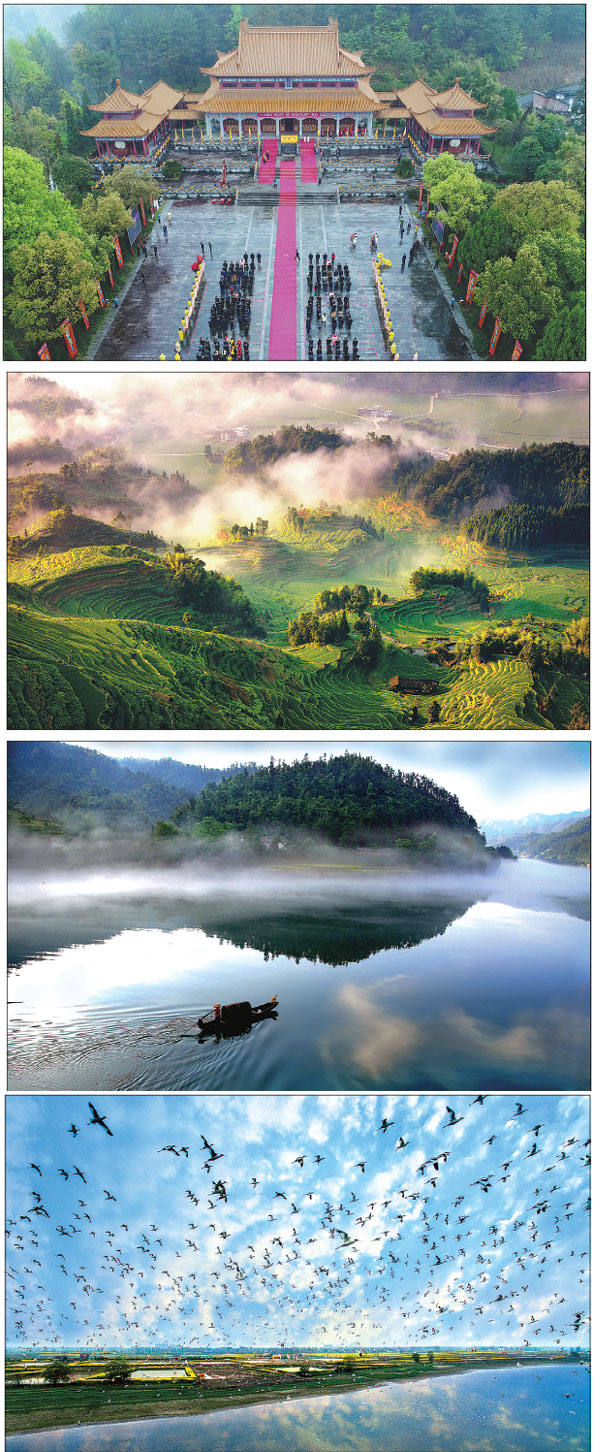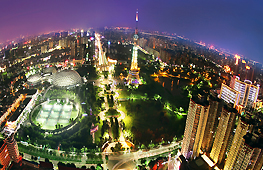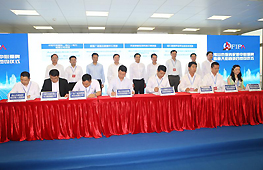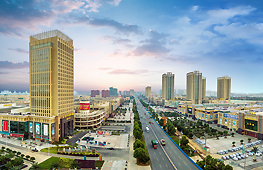History, cultural heritage areas of pride
Province in Central China is also home of many influential and talented celebrities, including thought leaders, artists, inventors and political figures, Yuan Shenggao reports.
Located in Central China, Hunan province boasts a splendid history and abundant cultural heritage.
Six exquisite, five-color glazed porcelains, presented at a news conference of the province in Beijing in late July, drew the attention of the media. The conference was held to brief the media on a series of events launched by the province in celebration of the 70th anniversary of the People's Republic of China on Oct 1.
|
Top from left: The former residence of Mao Zedong, a founder of the People's Republic of China, in Hunan province. The largest Fengyu (wind-rain) Bridge, an important structure in a Dong ethnic village, in Huaihua, Hunan province, can be dated back to more than 400 years ago. Yueyang Tower is depicted in a well-known Song Dynasty (960-1279) essay. Phoenix ancient town is a popular tourist attraction in Hunan. The Yuelu Academy in Changsha, capital of Hunan province, was among the top four private academies of classic learning in ancient China. Photos Provided to China Daily |
Four of the six porcelain vases were collected by the National Museum of China and the other two were to be kept by the museum in August, said Shen Bin, an inheritor of the technique of five-color glazed porcelains in Liling city of Hunan.
Shen described the products as "white as jade, clear as a mirror, thin as paper and sound like chime", which can display the oriental elegance to the world.
The technique of five-color glazed porcelains, listed among national intangible cultural heritage, can be traced back to more than 1,700 years ago and was invented at Liling Kiln.
In the early 20th century, the technique was improved in the company founded by Xiong Xiling, an industrialist and educator from Hunan, who employed top ceramists and introduced the most advanced manufacturing equipment.
The technical upgrade enhanced the quality of porcelains and enriched the colors of the products, improving their artistic and utility value.
Now Liling has become one of the biggest ceramic products export cities in China. In 2018, the important and export of the city totaled about $480 million, of which roughly 60 percent was contributed by local ceramics, according to official figures.
Besides the five-color glazed porcelains, Hunan has discovered a variety of historic relics, folk performances and products that have been carried on by generations.
There are 118 national intangible cultural heritage projects and 121 inheritors, as well as 324 provincial intangible cultural heritage projects and 304 inheritors in Hunan, according to local officials.
More than 30 sites of the Paleolithic period and more than 900 sites of the Neolithic period were discovered in Hunan, indicating the long history of the province.
According to the archeological findings and written records, the ancestors of Hunan people took root there more than 8,000 years ago, who mainly depended on primitive agriculture and poultry raising.
Well-known as a productive agricultural area throughout China's history, it laid the foundation for shaping Chinese farming culture.
The discovery of Chengtoushan archeological site in Lixian county in Changde was listed among the top 100 archeological findings in China in the 20th century. Dubbed the "earliest city of China", the well-preserved site can be dated back to more than 6,000 years ago.
The bronze piece Four Sheep Square Zun in the National Museum of China is the country's most well-known sheep-themed relic and renowned as the best example of bronze-making in Chinese history.
Excavated from a hillside at Ningxiang county in Changsha, capital of Hunan, in 1938 it was used as a liquor vessel at rituals in the late Shang Dynasty (c.16th century-11th century BC).
Hunan is closely linked with many celebrities. They include Qu Yuan, a patriotic poet during the Warring States Period (475-221 BC) who drowned himself in the Miluo River in Hunan out of despair over his king and motherland. Also, Mao Zedong, founder of the People's Republic of China, was born in Hunan and set out his revolutionary journey in the province.
Cai Lun, whose hometown was Leiyang of Hunan, improved the paper-making technology in the Eastern Han Dynasty (25-220). His innovation in making paper was included in the four great inventions of ancient China.
At the end of the Qing Dynasty (1644-1911), the last feudal empire in China, a group of thinkers and politicians from Hunan played an important role in promoting China's modern civilization and social progress. They included Wei Yuan, Zuo Zongtang and Tan Sitong.
Hunan is also home to Qi Baishi, one of the most noted contemporary painters in China. Yuan Longping, known as "father of hybrid rice", mostly lives in Hunan. He is still working on developing new species of rice on his mission to end starvation around the world.
|
From left: The tomb of Emperor Yandi, a legendary ancestor of the Chinese nation, is located in Zhuzhou, Hunan province. The Ziquejie Terrace Fields, a key agricultural heritage site in Loudi, Hunan province, has a history of some 2,000 years. Dongjiang Lake is a top-rated tourism site in the province. Dongting Lake, the second-largest freshwater lake in China, is a birds' paradise. Photos Provided to China Daily |






